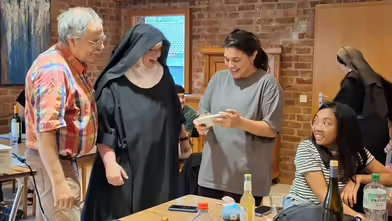Im Oktober werde ich in Freiburg einen Masterstudiengang in Umweltmanagement beginnen. Kürzlich hatte ich die Ehre, vor meinen Kollegen und den Benediktinerinnen in Argemund einen Vortrag über mein geliebtes Land Argentinien zu halten. Es war eine bereichernde Erfahrung, die es mir ermöglichte, grundlegende Aspekte der Kultur, der Politik, der Gastronomie, des Sports und meiner Heimatprovinz mit den Schwestern und der Klostergemeinschaft zu teilen.
Argentinien hat mit seinen 45 Millionen Einwohnern ein reiches kulturelles Erbe. Die Hauptstadt Buenos Aires ist bekannt für ihr pulsierendes Stadtleben und ihre historische Architektur. Tango, unser Nationaltanz, und Volksmusik wie Chacarera und Zamba sind für unsere kulturelle Identität von wesentlicher Bedeutung. Auch die moderne Musik nimmt mit dem nationalen Rock und dem Cumbia einen wichtigen Platz ein. Argentinien ist eine demokratische Republik mit einer starken Betonung der Gewaltenteilung: Exekutive, Legislative und Judikative. Unser föderales System umfasst 23 Provinzen und eine autonome Stadt, Buenos Aires. Das nationale Motto "In Einigkeit und Freiheit" spiegelt unsere Werte wider.
Die argentinische Küche ist berühmt für Asado, Empanadas und Dulce de Leche. Gerichte wie Milanesa und Locro sind bei nationalen Feiern üblich. Mate, ein traditioneller Aufguss, symbolisiert in unserer Gesellschaft Freundschaft und Gemeinschaft. Andere typische Getränke sind Wein, vor allem Malbec aus Mendoza, und Fernet mit Cola, der bei jungen Leuten sehr beliebt ist.
Zu den touristischen Attraktionen gehören die Casa Rosada, die Avenida 9 de Julio und das Teatro Colón in Buenos Aires. Im Süden befinden sich Naturwunder wie der Perito-Moreno-Gletscher und die Valdés-Halbinsel. Im Norden liegen Sehenswürdigkeiten wie die Quebrada de Humahuaca und die Iguazu-Fälle.
Was die nationalen Symbole anbelangt, so spiegeln das Hellblau und Weiß unserer Flagge mit der Darstellung des Inka-Sonnengottes Inti und Symbole wie das der Jungfrau von Luján, unsere Schutzpatronin, unsere reiche Geschichte und unseren Glauben wider.
Was den Sport betrifft, so ist der Fußball zweifellos die beliebteste Sportart in Argentinien und tief in der nationalen Identität verwurzelt. Wir haben legendäre Spieler wie Diego Maradona und Lionel Messi hervorgebracht. Auch Basketball ist sehr beliebt, mit internationalen Erfolgen der Nationalmannschaft, wie der olympischen Goldmedaille 2004, und namhaften NBA-Spielern wie Manu Ginóbili. Polo ist eine prestigeträchtige Sportart, die unsere reiterlichen Fähigkeiten widerspiegelt. Andere Sportarten wie Rugby, Tennis und Feldhockey sind ebenfalls sehr beliebt, und unsere Nationalmannschaften haben internationale Erfolge erzielt.
Ich wurde in der Provinz Santa Fe geboren, in der 3,5 Millionen Menschen leben. Die Hauptstadt ist Santa Fe de la Vera Cruz. Die Provinz ist bekannt für ihre Landwirtschaft, insbesondere für den Anbau von Sojabohnen, Mais und Weizen, die einen wichtigen Beitrag zu Argentiniens Exporten leisten. Santa Fe hat auch eine lange Tradition im Bierbrauen, mit bekannten Brauereien wie Santa Fe Beer. Während der Präsentation zeigte ich Fotos von der Puente Colgante, der Uferpromenade der Stadt, und dem Nationalflaggen-Denkmal in Rosario.

English:
My name is Paulina Guadalupe Belbey, I am 29 years old, and I am from Santa Fe, Argentina. I am currently in Germany taking a 4-month German course, and in October, I will start a master's degree in Environmental Governance in the city of Freiburg. Recently, I had the honor of giving a presentation about my beloved country, Argentina, to my colleagues and the Benedictine sisters in Argemund. The experience was enriching, allowing me to share fundamental aspects of culture, politics, gastronomy, sports, and my home province with the sisters and the monastery community.
Argentina, with a population of 45 million people, has a rich cultural heritage. Buenos Aires, the capital, is known for its vibrant urban life and historic architecture. Tango, our national dance, and folk music such as chacarera and zamba are essential to our cultural identity. Modern music also has a prominent place with national rock and cumbia. Argentina is a democratic republic with a strong emphasis on the separation of powers: executive, legislative, and judicial. Our federal system comprises 23 provinces and an autonomous city, Buenos Aires. The national motto "In Einigkeit und Freiheit" reflects our values of unity and freedom.
Argentinian cuisine is famous for asado, empanadas, and dulce de leche. Dishes like milanesa and locro are common at national celebrations. Mate, a traditional infusion, symbolizes friendship and community in our society. Other typical beverages include wine, especially Malbec from Mendoza, and Fernet with cola, popular among young people.
Among the tourist attractions are the Casa Rosada, Avenida 9 de Julio, and Teatro Colón in Buenos Aires. In the south, natural wonders like the Perito Moreno Glacier and the Valdés Peninsula. In the north, sites like Quebrada de Humahuaca and the Iguazu Falls.
Regarding national symbols, the light blue and white of our flag, with the representation of the Inca sun god Inti, and symbols like the Virgin of Luján, our patroness, reflect our rich history and faith.
In terms of sports, soccer is undoubtedly the most popular sport in Argentina, deeply rooted in national identity. We have produced legendary players like Diego Maradona and Lionel Messi. Basketball is also very popular, with the national team achieving international success, such as the Olympic gold medal in 2004, and notable NBA players like Manu Ginóbili. Polo is a prestigious sport that reflects our equestrian skills. Other sports like rugby, tennis, and field hockey are also very popular, and our national teams have achieved international success.
I was born in the province of Santa Fe, which has a population of 3.5 million people. The capital is Santa Fe de la Vera Cruz. The province is notable for its agriculture, especially the cultivation of soybeans, corn, and wheat, which significantly contribute to Argentina's exports. Santa Fe also has a long tradition in beer brewing, with well-known breweries like Santa Fe Beer. During the presentation, I showed photos of the Puente Colgante, the city's waterfront, and the National Flag Monument in Rosario.



